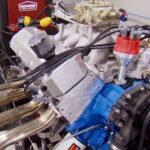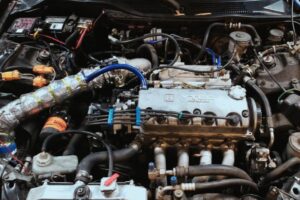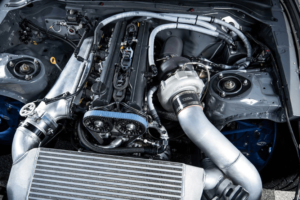Honda is known for building dependable cars with reliable engines. The Honda D16Y7 is one of these engines. Unfortunately, Honda has already stopped producing this engine. So, if you’re wondering if your Honda car has this engine, you may be interested to read this Honda D16Y7 engine specs and review.
The Honda D16Y7 is a 1.6 liter, 4-cylinder gasoline engine. Its key specs are the following:
- Horsepower – 106 hp. (79.0 kW) at 6,200 RPM
- Torque – 103 lb.-ft. (140 Nm) at 4,600 RPM
- Displacement – 1,590 cc (1.6 liters or 97 cu.in.)
- Stroke – 90.0 mm (3.54 in.)
- Compression ratio – 9.4:1
The Honda D16Y7 engine was produced by Honda Motor Co. from 1996 to 2000 for the Honda Civic and Honda Del Sol. According to its owner’s manual, this engine only uses regular fuel with around an octane rating of 87. It belongs to the D series of Honda engines.
Read on to learn more about the Honda D16Y7 engine, its specs, performance, and a bit of its background.
Honda D16Y7 Overview
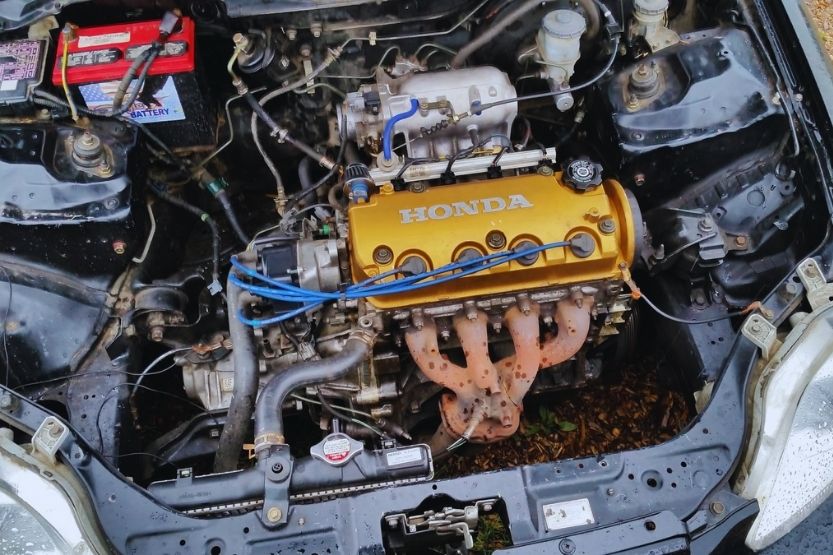
The Honda D16Y7 is one of the most reliable engines produced by Honda Motor Co. It has the following key specs:
- Engine size – 1.6 liters
- Number of cylinders – 4
- Horsepower – 106 hp. (79.0 kW) at 6,200 RPM
- Torque – 103 lb.-ft. (140 Nm) at 4,600 RPM
- Displacement – 1,590 cc (1.6 liters or 97 cu.in.)
- Stroke – 90.0 mm (3.54 in.)
- Compression ratio – 9.4:1
- Fuel type – 87 octane gasoline, regular
This engine belongs to the Honda D series engines manufactured by the Honda Motor Co. Engines starting with a “D” in the Honda line-up have inline-four-cylinder configurations.
Their displacements range from 1.2 liters to 1.7 liters. Honda started producing this D engine series in 1984. Then, the company ceased its production in 2000.
Honda Cars with Honda D16Y7
In its twenty long years of history, the Honda D16Y7 engine was used by Honda Motor Co to power different Honda car models. This engine was the heart of the following Honda car models:
- Del Sol S – 1996 to 1997 models
- Honda Civic Coupe LSI – 1996 to 1997 models
- Civic DX/VP/LX/CX – 1996 to 2000
- Honda Civic Special Edition (US) and SE/EX (Canada) – 1998 to 2000
How Many Horsepower Is a 5.3 Vortec?
Honda D16Y7 Specs
If you are an owner of an older model of Honda Civic or Honda Del Sol, it is more than likely that its engine is a Honda D16Y7. You will be interested to know its specifications. It’s good to know what your engine is capable of doing.
VTEC Technology
Honda is known for developing VTEC technology. But did you know that this engine does not use VTEC technology? And unlike the popular engines that Honda produced in the 1990s, the Honda D16Y7 does not have dual overhead cams.
Another interesting fact you need to know about this engine: Honda started producing it in 1996. They used it to power the base model of Honda Civics and Honda Del Sols at that time. Sadly, the car manufacturer ceased its production in 2000.
So, the Civics and Del Sols 2000 year models are the last ones fitted with this engine. To some people, these car models will later become collector’s items.
Summary of Honda D16Y7 Engine’s Specs
Anyways, I know you are very much interested in its specs. The table lists the specs of the Honda D16Y7 engine:
| Engine Details | Specification |
| Engine Size, (displacement) | 1.6 liters |
| Number of Cylinders | 4 |
| Type | Naturally aspirated |
| Horsepower | 106 hp. (79 kW) at 6,200 RPM |
| Torque | 103 lb.-ft. (140 Nm) at 4,300 RPM |
| Compression Ratio | 9.4:1 |
| Bore | 75.0 mm (2.95 in.) |
| Stroke | 90.0 mm (3.54 in.) |
| Valvetrain | SOHC (Four valves per cylinder) |
| Rev-limiter | 7,200 rpm |
| Redline | 6,800 rpm |
| Fuel Control | OBD2 MPFl |
Performance Specs of the Honda D16Y7 Engine
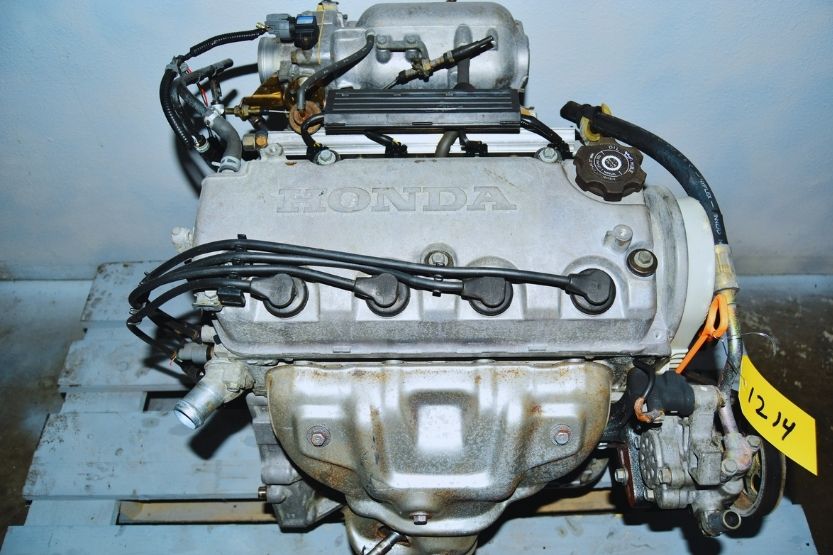
Now we come to one of the most important specs that car owners look at the cars they want to buy – its performance specs. The Honda Civic base model powered by the Honda D16Y7 was not sold as a high-performance car.
Delivers 106 Horsepower and 103 lb.-ft of Torque
It can only deliver 106 horsepower and 103 lb.-ft of torque. This engine was not very popular among car tuners at that time. This engine only has one overhead cam and does not have VTEC technology.
Great Fuel Efficiency
Its three engine models, the DX, LX, and CX have great fuel efficiency. They could get 32 miles per gallon in the city and 37 mpg on the highway. In contrast, the Honda Civic EX model, a high-performance model, can only achieve 30 mpg city and 35 mpg highway.
Engine Displacement
The number ‘16’ attached to the engine name stands for 1.6 liters, its engine displacement. That’s about 97 cubic inches in English measurement. Its compression ratio, according to Honda, is 9.4:1. The engine’s bore x stroke is 2.95 in. x 3.54 in. (75 mm x 90 mm).
Engine Modifications
This engine has undergone many modifications throughout its twenty-year history. These revisions were made on the Honda cars that this engine class has powered.
Now, there are many car tuning enthusiasts that toy with the Honda D16Y7. But the earlier versions of this engine did not catch their interest.
Two models of this engine class, the SOHC VTEC-based D16Y8 and the D16Z6 did not reach the market until the 1990s. They are two of the more popular performance engines in this product line.
Many Honda car enthusiasts were comparing the D16 to the Honda B16, a performance model, saying that the former could not match the latter’s legacy.
They never knew that at the beginning, Honda Motor Co had economic objectives as its primary focus for the development of the D16 engines and not high performance.
D16 Engine’s Compression Ratio
Throughout the history of the D16 engine, its compression ratio was modified from 9.1:1 to 12.5:1, with its displacement of 1,590 cc. or 1.6 liters.
Cast Aluminum Cylinder Block and Head
Structurally, the cylinder block and cylinder head of the D16 engines were made of cast aluminum. It has an inline configuration with SOHC, DOHC, VTEC, and non-VTEC variations.
Maximum Power
In the beginning, the Honda D16Y7 could only deliver 103 horsepower. But Honda later modified the engine’s design so that it was able to crank its maximum power using its stock parts. Its torque output ranged from 99 ft.-lb to 116 ft.-lb.
Again, is the Honda D16Y7 a good engine? Honda D16Y7 engines are lightweight, equipped with VTEC technology, and, lastly, they are cheap.
Honda D16Y7 Turbocharging Potentials
Its attractive price and availability make the Honda D16Y7 a good candidate for turbocharging and supercharging.
Check the Engine Block’s Quality
But before you embark on this project, be sure that the engine block is still of good quality by checking if the engine has any underlying issues. Any imperfection in the engine block will be exposed if you will perform an engine compression test.
It is entirely possible if you are interested in turbocharging your existing Honda D16Y7.
Affordable Turbochargers and CXRacing Devices
There are turbochargers and CXRacing devices sold at very affordable prices that can increase the power of your stock engine from 300 to 350 hp. Some high-powered setups can even bring their horsepower up to 400 to 500 hp.
Supercharger Options
These CXR racing units will give you great value for your money and the proper supporting modifications and management. If you want more and want a supercharger, the Jackson Racing and Kraftwerks are the most popular options.
Follow the Experts’ Advice
You should heed the advice of the experts if this is the route that you want to take. They recommend that you should not take any shortcuts in buying a Honda D16Y7 rebuild kit. Don’t go the way of the cheap route, or you will destroy your engine block.
How Much HP Does a Turbo or Supercharger Add?
How to Tune and Upgrade the Honda D16Y7
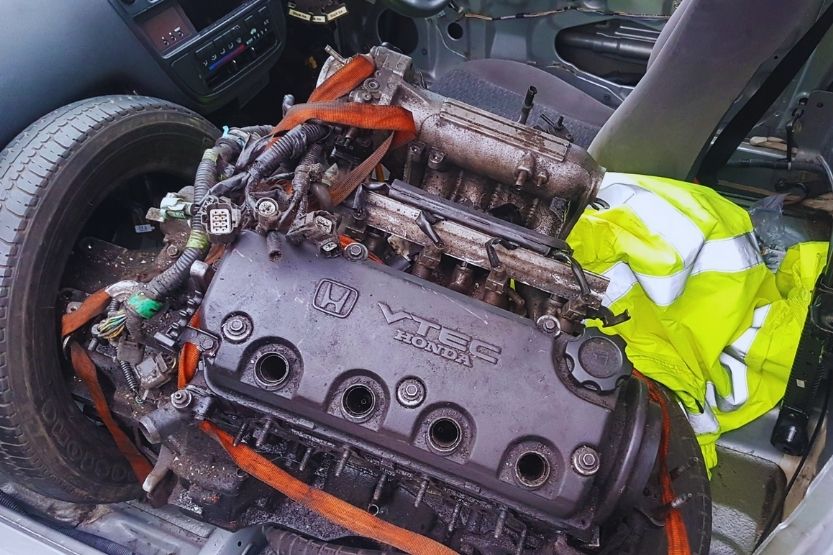
Honda enthusiasts experimented more with the Honda B16 engine than the Honda D16Y7. However, that doesn’t mean that you can’t tinker with the design of the Honda D16Y7.
This engine is good for modification due to its low factory output and displacement. However, as in everything, you have to find a way to unlock its potential power capacities if you are willing to do the required work.
There are Honda enthusiasts who have tuned up their D16 engines to crank 500 horsepower. Some even have pumped up the horses of their engines up to a staggering 700 hp. So, you can see the potential of your own trusty Honda D16Y7.
Y7 Manifold Replacement
When tuning the Honda D16Y7, more airflow of cold air into the engine is better. One of the most popular upgrades for this engine is to replace the Y7 manifold with a Y8 manifold.
Y8 Manifold Increases Airflow
The Y8 air intake manifold is reasonably priced. But it will allow increased airflow into your current D16 engine. Like other modifiers, you can also buy an aftermarket exhaust. While it will not increase the engine’s power, it will undoubtedly improve the looks and sounds of your exhaust pipe.
If the engine is naturally aspirated, an inner diameter of around 1.5 inches to 2.5 inches will be good for the exhaust pipe. But if your end goal is forced induction, make sure that you install a bigger diameter, so you don’t need to swap one exhaust size to another.
Consider Having a Panel Air Filter or a Cold Air Intake
Besides the exhaust pipe, you should also consider having a panel air filter or a cold air intake. This will improve the responsiveness and sound of the engine, although it may only add a little to its cranking power.
Upgrade the Engine’s Camshaft and Its Headers
Once you have done that, the next thing you can upgrade is the engine’s camshaft and its headers. You can also think about adding a piggyback ECU. Other upgrades you can consider further down the road are the following:
- Full exhaust systems
- High-flow injectors
- Ported and polished engine head
- Fuel pump
Piston and Cam Upgrades
All these upgrades that you can perform on your Honda D16Y7 will make your engine function optimally. And if your pocket is that deep, you can go for piston and cam upgrades and add other extras like titanium retainers and bigger valves.
Honda’s Hondata Systems
If you have reached this far on your Honda D16Y7 mods, you may need to think about engine management. This is where Honda’s Hondata systems will be beneficial. But you can also choose to have an ultimate setup such as a standalone management system.
As you go deep into the car tuning rabbit hole, particularly the cams, your Honda car will be noisier for daily use. If it is your daily driver, you should think twice before going this far.
Honda D16Y7 Common Issues
Very Few Issues with the D Series Engine
Honda had very few issues with its D series engines in all the 12 years they have been producing it before introducing Honda D16Y7 in the market.
It is not unusual to find second-hand Honda Civics powered by Honda D16Y7 engines with 300,000 miles on their odometer and are still in good running condition.
Lightweight Engine
This engine is lightweight, with its engine head and block being made of aluminum. The engine head has a single overhead cam, and every cylinder has four valves. With just one overhead cam, the cost of this engine was kept low, and its maintenance was minimal as well.
Still, the Honda D16Y7 has encountered several problems. Here are some of its issues:
- Oil leaks – this should be easy to spot.
- Rough idle can be due to a dirty idle control valve or a dirty throttle body.
- Misfiring
- Noisy engine, almost like it’s a diesel engine – this can be due to an issue with the intake manifold. Remove it and check for cracks.
Solid Reputation as a Builder of Dependable Engines
While you may encounter these issues with your Honda D16Y7 engine, overall, you can still rely on it as Honda has a solid reputation as a builder of dependable engines. Regular service and maintenance will take more than 180,000 to 200,000 miles.
If you heavily modify it with upgrades and kits, you can reduce its lifespan. However, if you regularly perform service checks and maintenance works, you can expect it to last many thousand miles more.
A Short Background of the Honda D16Y7 Engine
21 Years of Production Run
The production run of the Honda D16Y7 engines lasted 21 years. In those years, Honda had enough time to work out the issues that it had encountered. You can still see these engines powering Honda Civics and Del Sols today.
Honda D16Y7’s Predecessor
The predecessor of the Honda D16Y7 was the D15B7 which it replaced in 1996. In that year, Honda Civics had increased its engine displacement from 1.5 liters to 1.6 liters. With this upgrade, the Honda D16Y7 added four horsepower to the existing hp. of the Honda Civic.
Fitted with the New Onboard Diagnostic System
A new emission law was being implemented at its launch in the United States. The government required all cars made in the country to have the new OBD II system. So the Honda D16Y7 was fitted with the new Onboard Diagnostic system that all cars are still required to use today.
Honda Civic Car Models with Honda D16Y7
At that time, Honda used the Honda D16Y7 on the DX, LX, and CX variants of the Honda Civic car models. But they were not considered high-performance engines during those days because the engine could only crank 106 hp.
Replacement of Honda D16Y7 Engine
Later in 2001, Honda Motor Co replaced the Honda D16Y7 engine with the Honda D17A1 engine. Again, Honda increased the engine’s displacement from 1.6 liters to 1.7 liters. This upgrade increased the cranking power of the engine to 115 hp.
When Honda discontinued the production of the Honda D16Y7, it increased the size of the engine that they used to power the base models of the Honda Civic.
Frequently Asked Questions
If you want to remember the salient points about the Honda D16Y7 engine that I have discussed in this article, just read the below answers to the often asked questions about this engine:
What Are the Key Specs of the Honda D16Y7 Engine?
The key specs of the Honda D16Y7 engine are the following:
- Engine size and type – 1.6-liter, 4-cylinder gasoline engine.
- Horsepower – 106 hp. (79.0 kW) at 6,200 RPM
- Torque – 103 lb.-ft. (140 Nm) at 4,600 RPM
- Compression ratio – 9.4:1
- Stroke – 90.0 mm (3.54 in.)
Is the Honda D16Y7 a Reliable Engine?
Yes, it is a reliable engine. Honda has kept its production for 20 long years without encountering major issues about its reliability and durability. There are older models of Honda Civics that are still running in the streets around the United States, with this engine powering them.
What Is the Fuel Used by the Honda D16Y7?
The Honda D16Y7 naturally aspirated engine uses regular gasoline with an 87 octane rating.
In Closing: Honda D16Y7 Engine Specs and Review
The Honda D16Y7 is a 1.6- liter gasoline engine with 4-cylinders. Its key specs are the following:
- Horsepower – 106 hp. (79.0 kW) at 6,200 RPM
- Torque – 103 lb.-ft. (140 Nm) at 4,600 RPM
- Displacement – 1,590 cc (1.6 liters or 97 cu.in.)
- Stroke – 90.0 mm (3.54 in.)
- Compression ratio – 9.4:1
This engine belongs to the D series of Honda engines produced by Honda Motor Co. from 1996 to 2000.
It was designed for the Honda Civic and Honda Del Sol. As per its owner’s manual, Honda D16Y7 only uses regular fuel (about an 87 octane rating).
Read next:
Interference and Non-Interference Engine List
What Is the Difference Between 2-Stroke and 4-Stroke Engine?

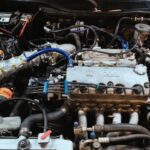
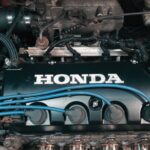
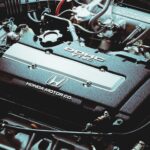
![Interference Engine List [and Non-Interference Engine List] interference engine list](https://roadsumo.com/wp-content/uploads/2021/06/interference-engine-list-150x150.jpg)
![Check Engine Light On and Off Intermittently [Causes and Fixes] check engine light on and off](https://roadsumo.com/wp-content/uploads/2021/06/check-engine-light-on-and-off-150x150.jpg)
